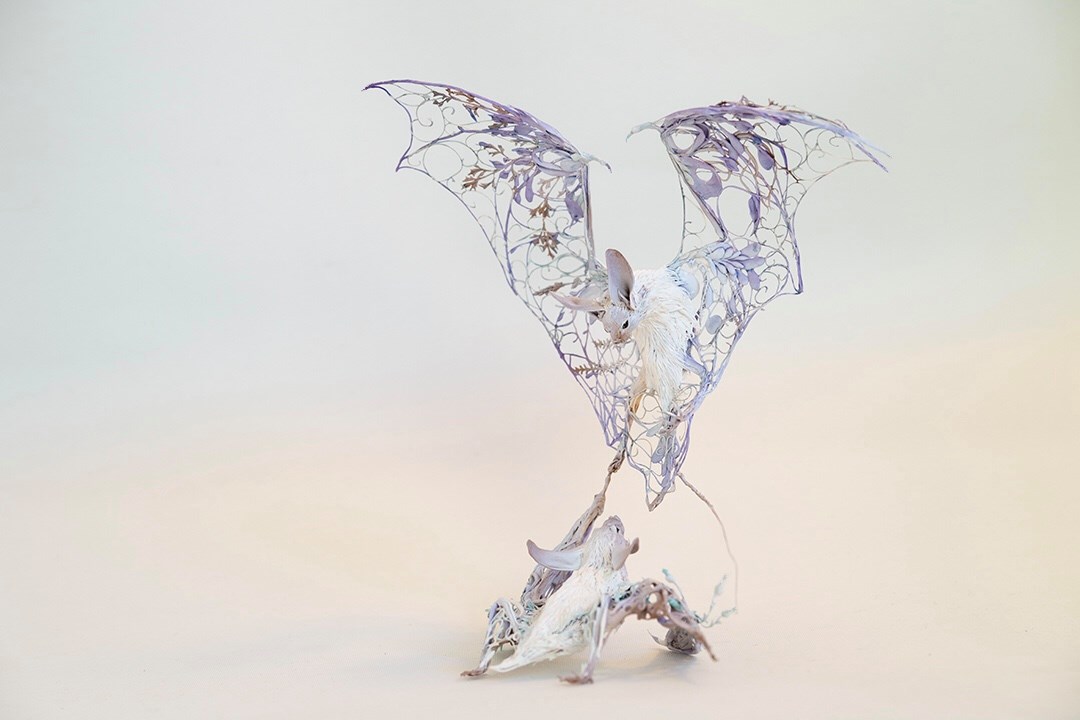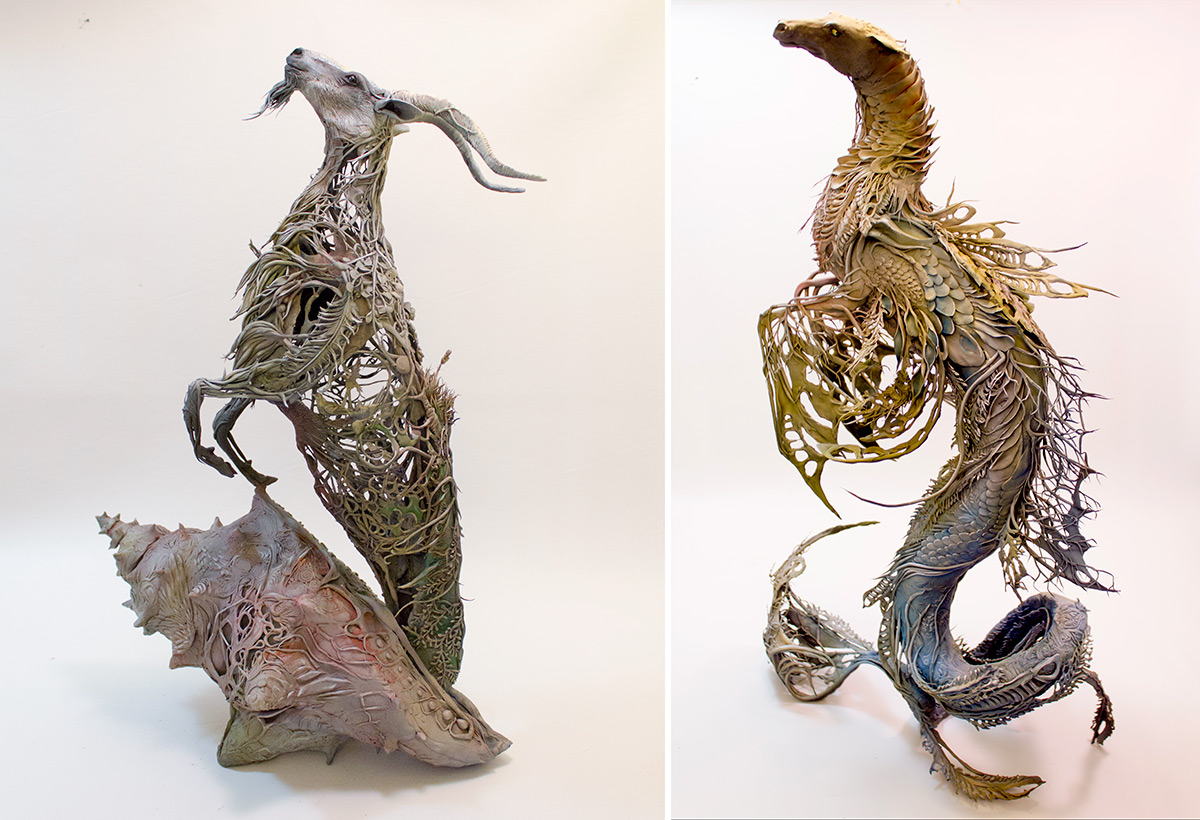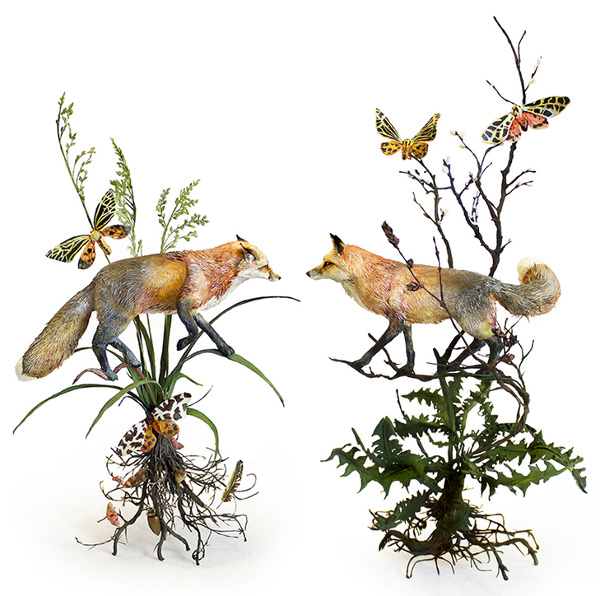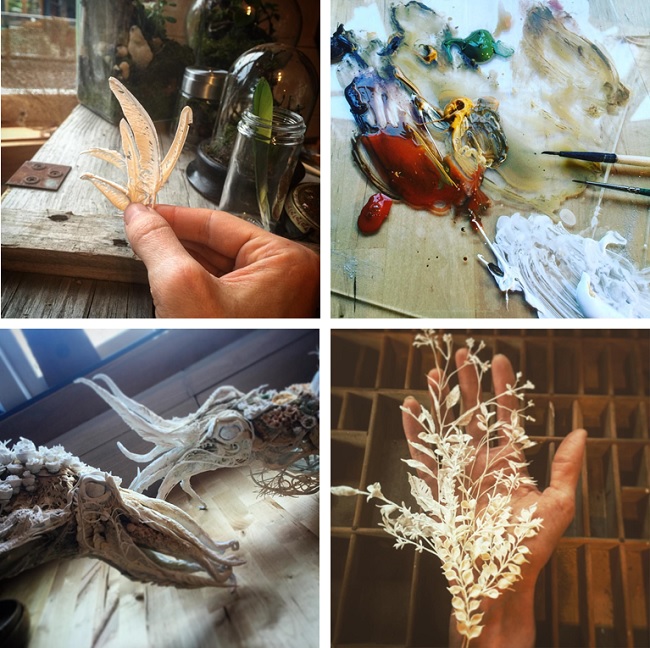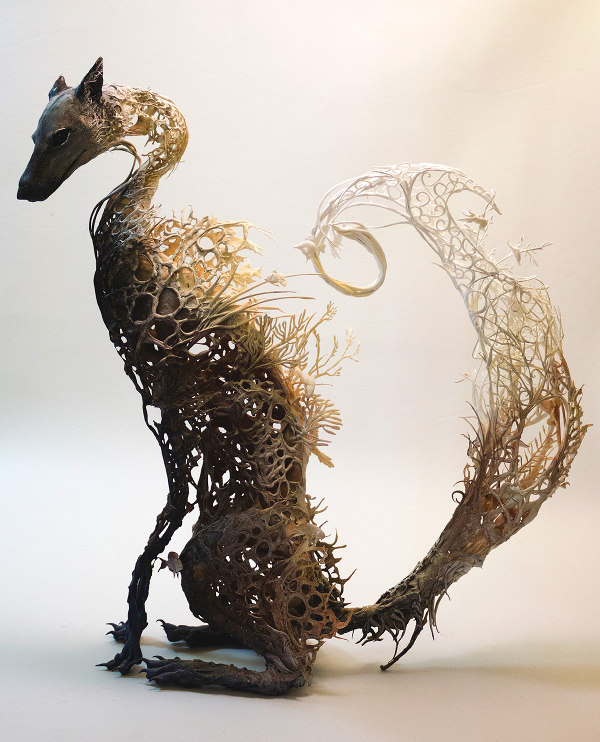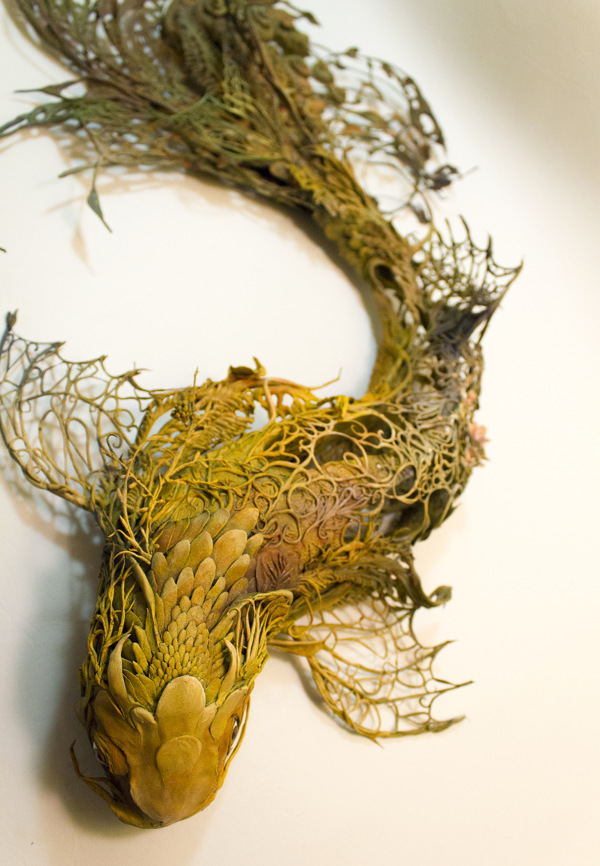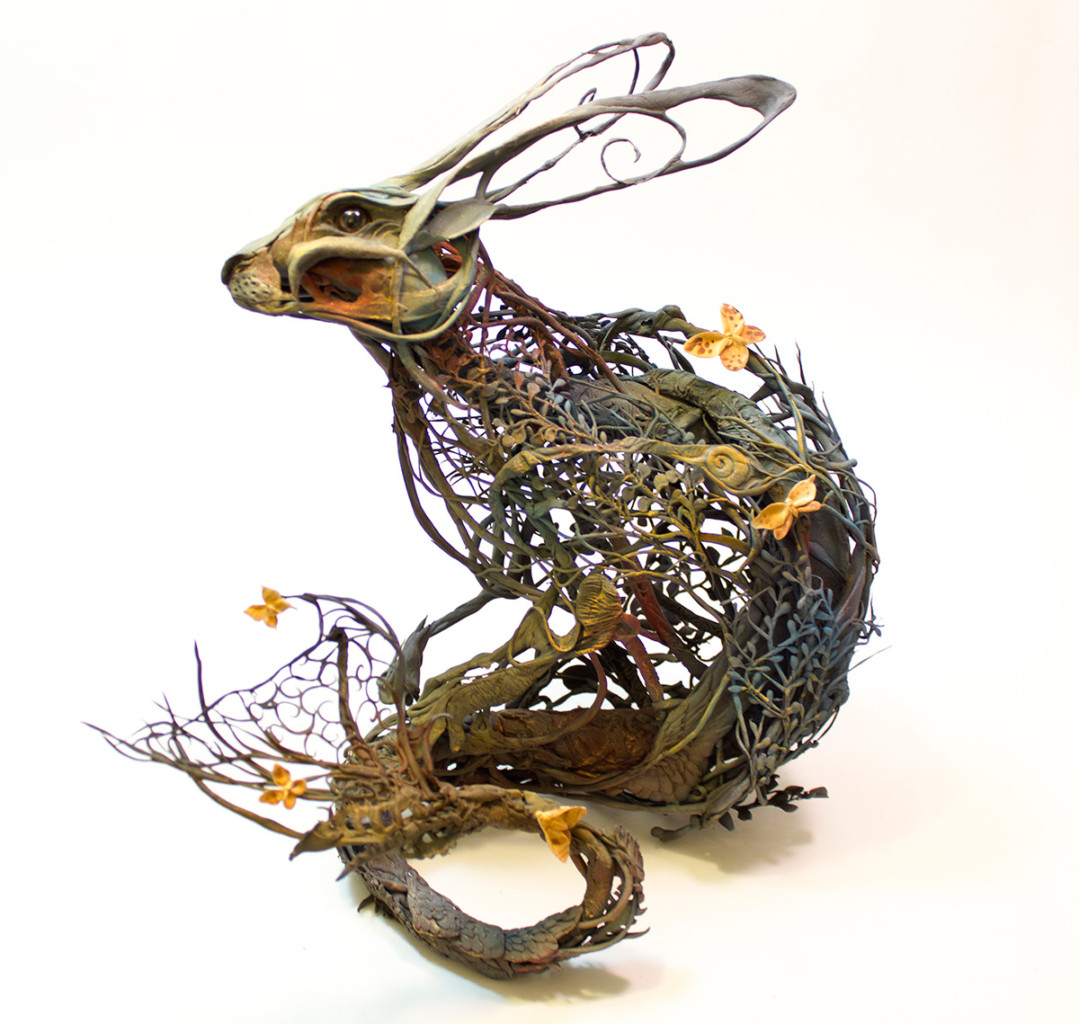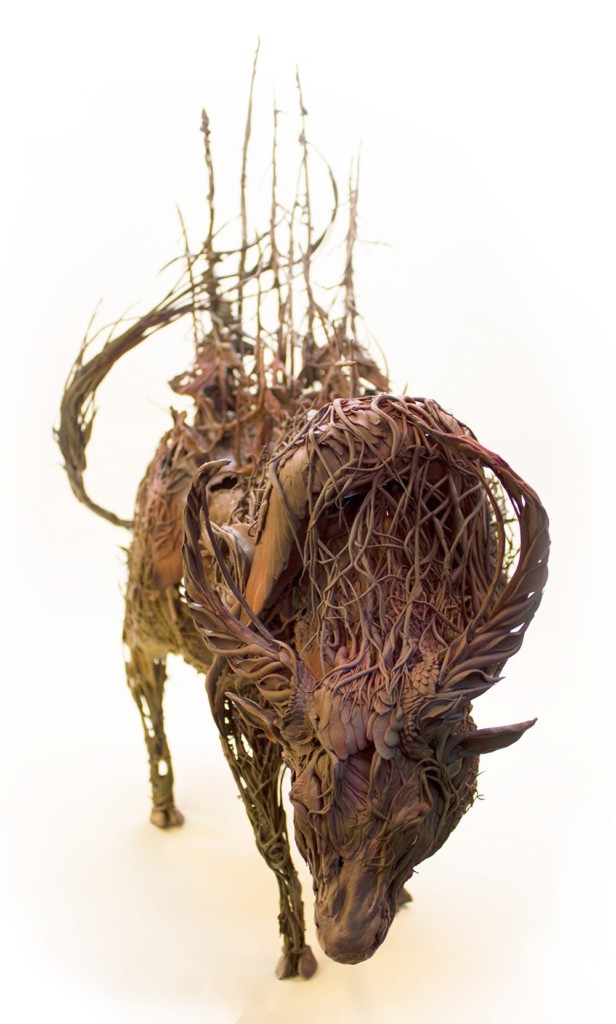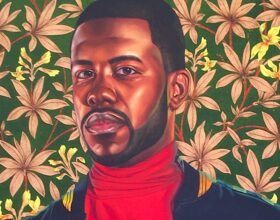Graceful and intellectual, hearing Ellen Jewett describe her works seems to add more layers to each sculpture rather than peeling them back. But it’s not so much about getting to the core of her art; as with all good stories, there is just as much fun in taking the journey as there is relishing in the end product.
Understanding more about Ellen’s broad array of experiences and personal insights is not only a pleasure to help us see her otherworldly sculptures in a new light. They allow us to better see into the heart and mind of this elusive artist who chooses, often, to keep behind the scenes and let her art just speak for itself.
Interview with Ellen Jewett conducted in conjunction with her editorial in Issue 14 of Beautiful Bizarre Magazine.
Thank you Ellen for taking the time to speak to us at Beautiful Bizarre Magazine, we really appreciate it! So to begin, can you give us a brief history of your background?
I grew up in Ontario Canada. I was raised in a very metropolitan area but was more strongly influenced by summers spent further north in undeveloped countryside where I could walk in the woods and spend time by the lakeside.
Do you think there is a defining moment in your life that put you on this path as an artist?
There are probably many, but the one I find myself going back to was a teacher I had in high school. I took a small elective class called ‘ceramic sculpture’ whereby we were supposed to make pots and simple figures. Shortly after the class started my instructor told me she didn’t know what she really had to offer me, but as long as I came into class and creating things I didn’t have to partake in the assignments, I could just be free to use the studio space for whatever I wanted. Until that point I had been aiming for a career in the sciences but being given free access to a sculpture studio helped me realize that sculpting was what I wanted to do with my time more than anything else did in this world.
Your trademark style as an artist is very distinctive. How did you get into sculpting?
Simply put, I have always sculpted. Learning to sculpt for me developed right along with walking and talking. It has been a passion and a compulsion. My parents provided me with Plasticine as a child and I put thousands of uncounted hours into playing with it. As I grew I found that I could sculpt almost anything almost anywhere, it was hard for me to leave so much as a Christmas dinner without a few animals sculpted in sparkly foil wrappers being left on the table.
Why animals? I have always had a bewitching attraction to the otherness of animals. Knowing them is to know other nations and ways of being in and experiencing this world. I want the psychological impact of my work to express some of the expansive gulf between the human and non-human animal experience of being and connecting in this world.
Do you have a favourite animal that you like to create?
There are certain creatures and motifs that exist in the menagerie I create that I return to over and over. Dogs, foxes, deer, octopus, koi, ravens and elephants would probably be the most common. I’m rarely too ‘species specific’ in my reference. My ‘canines’ for example are most often an amorphous creature on the dog-wolf-coyote spectrum. I have a visual bias towards streamline, flowing forms and tend to bring those qualities out of any animal subject.
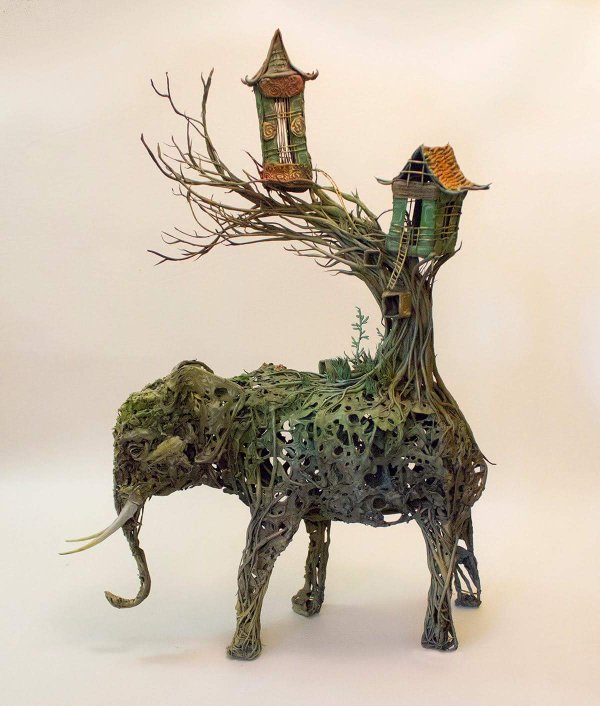
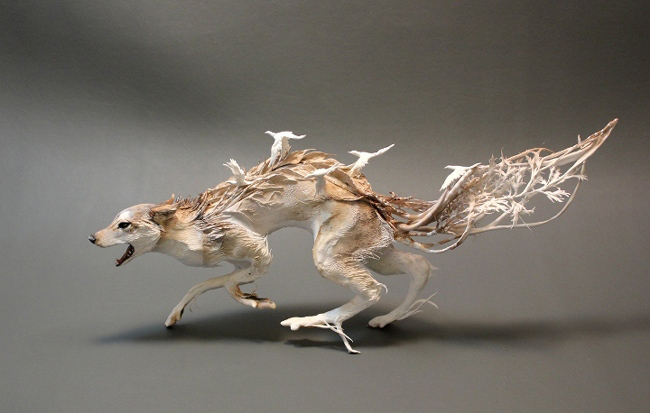
How would you personally describe the style of art you create?
I describe it as ‘natural history surrealism’. feel like I approach my subjects as a surrealist; I place a stronger focus on the psychological landscape of a subject’s narrative rather than a literal adherence to a corporeal reality. ‘Natural history’ refers not only to my adherence to plant and animal subjects but also the strange colonial connotation that label carries.
It’s interesting that you mention a ‘strange colonial connotation’; do you feel like you are making characters for a new, self-created colony?
That’s a fascinating read on my work and something I would suggest is a possibility but not deliberately created as such. I see my work as more reflexive, whereas traditional natural history images sought to define and assimilate wildness and the other to essentialized details; defining a creature to a species name, colour pattern, habitat and way of being. My work speaks to expand upon them, using surrealism as a visual metaphor to suggest but not confine complexity, interconnectedness, relationships….
Obviously animals are a great influence, but do you have a particular muse?
My ‘go to’ way to capture my muse would be taking a day hike somewhere; the forest, the sea shore, a city core or, in a pinch, the orchard near my studio will do. I usually bring one of my dogs or other animals with me on a given walk which helps draw my attention to other details of the landscape I might pass over otherwise. As a detail oriented person it is the little things I am drawn to; moss overtaking a wooden plank, the smoothed edge of a shell fragment, a tiny fossil in the cliff face.
It’s clear that your impressively vast educational background has influenced your creations – the amalgamation of art and science seems to have put you in a well-balanced position to see the world. Is there anything you regret, or would like to expand on to further influence you and your work?
I don’t think I am the type of person who has regrets, and I mean this in a resolutely self-accepting way, as opposed to taking a position of arrogance. If I could mentor my younger self there are many things I’d approach differently, but that’s not to say I have regret. For me, creativity has is typically believed of all artists, come from strife. However even more often it has come from a place of psychological wellness and abundance. I’ve always made decisions with one eye to keeping my life rich with that which inspires me, animals, wilderness, knowledge, art and responding to my own needs on a wellness level. This has come out in everything from the mediums I use; uncompromisingly as non-toxic as possible, to where I choose to work; a studio out in the countryside as opposed to the city art scene. I am fascinated by the field of positive psychology and keep that research in mind when I try to answer the questions of how shall I live and work. Moving forward I want to simply expand and evolve on this process I have started. I want to learn more, cultivate more skills and knowledge.
My sculptures are byproducts of how I interpret several facets of this world that fascinate me the most. They are also my primary contribution at this point to any sort of influence I have on the world outside my interpersonal relationships. I would say they are tremendously helpful [to me personally].
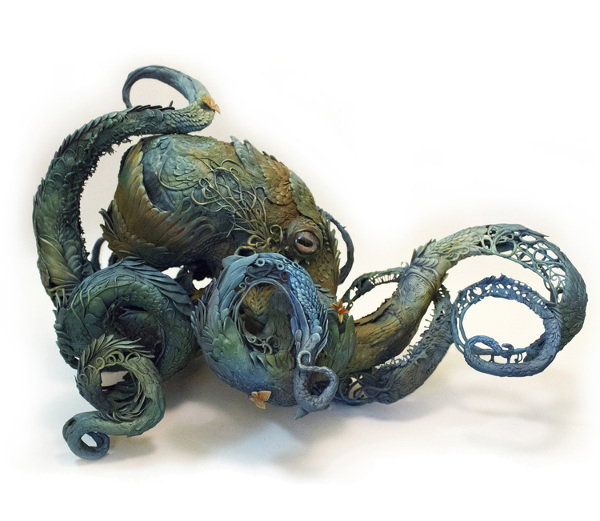 Every one of your sculptures look indescribably intricate! Can you describe your process from beginning to end?
Every one of your sculptures look indescribably intricate! Can you describe your process from beginning to end?
This is tricky because I am inconsistent and playful in my creative process; not overly formulaic. So I don’t always create in the same order, and I frenetically hop between on-going projects. But some elements/stages are typical and coherent. I usually work from the inside out, so starting with the core of a creation and then building the sculpture up layer by layer. At least some of this first layer must be metal armature which is often further built upon as I scaffold outwards. All of the details need to have a metal core to remain resilient. I lay the sculpture onto the piece in layers, generally with a back to front trajectory, leaving the face until the last. After all the sculpted layers and been put together and dried in full I will add paint, pigments and sometimes embedded elements. I usually ‘finish’ a piece only to put it through a several rounds of revision and tweaking until I’m willing to let it leave the workshop.
What are your primary materials to create your sculptures?
I have gone through a long laundry list of materials to ‘try and find what I am looking for’. Today my practice mostly focuses on air drying clays on a metal armature or matrix that is painted with acrylic, oil and raw mineral pigments. My material choices are less related to superior working properties and more to my desire to work in as low a [harmful] chemical environment as possible. Which is to say I often preference ‘hard to work with’ materials because they are non-toxic. This is both for environmental and personal reasons.
It’s hard not to wonder how long, on average, it takes to physically create a sculpture…
This is another difficult question for me. I suppose a vague answer like ‘months to years’ will have to suffice for my larger sculptures.
That said if I was stuck in a reality television show and had to ‘sculpt against the clock’, without regard to internal armatures, curing, painting etc. I would probably be a contender for world champion. As anyone who has seen me demo can attest, I can sculpt very very quickly. However to build my exhibition pieces with the integrity I feel they deserve takes a long time to make the proper armature, research and source all the different little components and work in the layered manner I prefer. There is no question that making sculpture without the use of technology, whether it’s ancient caste moulding or modern 3D printing, is one of the most labour intensive of the traditional arts. That is the nature of the beast.
Now that would be a reality t.v. show I would watch! Talking of audiences, what do you hope or aim for your audience to absorb from your pieces?
I’ve always been drawn to details, little things that pull me in and beg a closer look, and the narratives that unravel when I am there. I am also drawn the striking beauty of things that are wild, or possess a wildness; a push and pull of identifying with and feeling alienated from. I think these are all the things I want my art to bring to viewers generally. There are often specific stories embedded in my sculptures in the midst of the overarching themes, but I am not here to tell them, or have the viewer be able to read them verbatim. I want people to extract their own interpretations and narratives.
You stated in another interview that stubbornness is an essential tool for an artist – “here and now… a lot of the support needs to be self generated”. Have you ever felt moments where it has been a real struggle to find the motivation to carry on as a professional sculptress?
I think to produce art professionally it is helpful to remember you are going to need to wear many hats, that of a creative entrepreneur, a business owner, a strategist and a labourer, in addition to the full complement of skills related to creating a work of art.. traditional educational styles do not easily endow artists with this eclectic skill set or frame of mind. It takes a level of self generated persistence to learn these skills and balance them in daily life.
I have specific days when I would really rather do something other than go to the studio, but my work is a labour of love. It is self-rewarding and even on ‘off’ days I can usually motivate several hours out of myself. Have I ever considered not sculpting professionally? No, never. I think often about what else I can fit into my life in-addition-to, but to contemplate if I could ever not be a sculptor is unthinkable to me. In the event of ever being seriously inhibited physically or psychologically I believe I would simply alter my practice to accommodate myself and keep on producing. I also don’t think I would step away from the professional aspect either to ‘do it for myself’. I suppose if I could be economically liberated from needing to generate an income that would be wonderful, I could produce for public or charities interest only. But that I would continue to produce is not a question, and the fact that I have never felt a compulsion to keep one of my own sculptures is demonstrative that I don’t produce them for myself. The sculptures, as legal property, do end up belonging to specific collections or collectors. But they are made ‘for’ anybody and everybody who wants to look at them, on the internet or otherwise.
Has your design and creation processes changed or adapted in light of your newer artworks?
In terms of design as I have developed as an artist, I have challenged my sculptures to visually ‘work’ in multiple dimensions. A captivating three-dimensional sculpture does not necessarily work in two dimensions but this is something I’ve decided to demand of them. I want my sculptures to start capturing some of the flow and delicacy of paintings and the vivid graphic use of sharp line and form of prints. This has meant challenging my pieces to defy gravity, so they float through the air like water colour brushed gently on paper. I feel the process of trying to achieve this has allowed me to explore more of the connection to natural history illustration that has always been a source of inspiration for my work.
That aspiration sounds not only impressive but very exciting. I can’t wait to see how your work continues to evolve. Looking forward, do you have any other specific aspirations for the future?
I would like the opportunity to work on larger projects and have more time to be perfecting and precious with my creation.
Ellen Jewett Social Media Accounts
Website | Facebook | Instagram | Tumblr | Pinterest | Twitter


